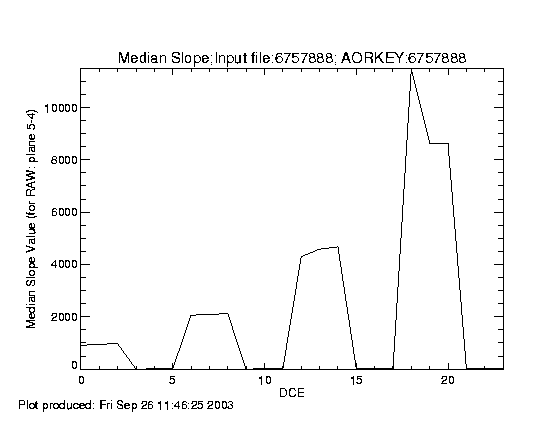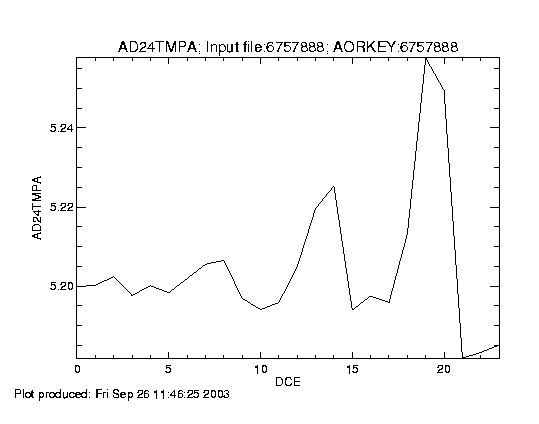Results
The following are the median brightnesses for each of the DCEs.
Filename median (DN/s) Stim Level
MIPS.1.0006757888.0000.0000.01.mipl.fits 1808 FloodB low
MIPS.1.0006757888.0000.0001.01.mipl.fits 1908 FloodB low
MIPS.1.0006757888.0000.0002.01.mipl.fits 1934 FloodB low
MIPS.1.0006757888.0001.0000.01.mipl.fits 0 AllOff --
MIPS.1.0006757888.0001.0001.01.mipl.fits 12 AllOff --
MIPS.1.0006757888.0001.0002.01.mipl.fits 12 AllOff --
MIPS.1.0006757888.0002.0000.01.mipl.fits 4114 FlatA low
MIPS.1.0006757888.0002.0001.01.mipl.fits 4196 FlatA low
MIPS.1.0006757888.0002.0002.01.mipl.fits 4226 FlatA low
MIPS.1.0006757888.0003.0000.01.mipl.fits 2 AllOff --
MIPS.1.0006757888.0003.0001.01.mipl.fits 14 AllOff --
MIPS.1.0006757888.0003.0002.01.mipl.fits 14 AllOff --
MIPS.1.0006757888.0004.0000.01.mipl.fits 8586 FloodB high
MIPS.1.0006757888.0004.0001.01.mipl.fits 9172 FloodB high
MIPS.1.0006757888.0004.0002.01.mipl.fits 9346 FloodB high
MIPS.1.0006757888.0005.0000.01.mipl.fits 14 AllOff --
MIPS.1.0006757888.0005.0001.01.mipl.fits 22 AllOff --
MIPS.1.0006757888.0005.0002.01.mipl.fits 20 AllOff --
MIPS.1.0006757888.0006.0000.01.mipl.fits 22948 FlatA high
difference image 24530
MIPS.1.0006757888.0006.0001.01.mipl.fits 17262 FlatA high
difference image 25520
MIPS.1.0006757888.0006.0002.01.mipl.fits 17220 FlatA high
difference image 25682
MIPS.1.0006757888.0007.0000.01.mipl.fits 32 AllOff --
MIPS.1.0006757888.0007.0001.01.mipl.fits 32 AllOff --
MIPS.1.0006757888.0007.0002.01.mipl.fits 28 AllOff --
The following results were found in ATLO ground testing with CE1:
00-349 01-117 220 286 02-224 292 03-022 039 070 128 170
HTSINK Tmp: 2.255 1.965 1.547 1.463 4.5 5.4 ?? 4.54 4.58 5.51
MICBP Tmp: 2.535 2.396 1.623 1.586 4.5 5.4 ?? 4.75 4.79 5.68
24umFlatA: 4014 4068 4100 4114 4200 4280 4200 4190 4202 4272 4398
24umFloodB: 1896 1926 1930 1928 1940 1965 1950 1945 1953 1971 2014
The HTSINK and MICBP temperatures during campaign D1 were roughly 1.32K.
The expected brightness for 24FlatA was about 4100 +/- 100 DN/s, and for
24FloodB the expected brightness was about 1930 +/- 30 DN/s. The ground
test results are always for the 2nd DCE of a pair of stim DCEs, so the
comparison values from campaign D1 are 4196 DN/s and 1908 DN/s, both of
which lie within the expected range from ground testing. There is not
adequate ground data to predict the bright stim levels. They were set
very high for possible use in photon-flood anneals. 24FlatA is set
adequately bright for this purpose, but 24FloodB would need to be turned
up brighter if we wanted to use it for a photon flood anneal.
As had been seen from the ground, the slope measured by the first DCE in
each exposure is typically 5% lower than the value measured on subsequent
DCEs. (Could this be due to the spacecraft slope fitting algorithm assuming
that the exposure time for DCE0 is the same as all subsequent DCEs? The exposure
time for DCE0 is shorter by 1 second, due to the two bias boost frames at
the start of the exposure.) However, the highly saturated 24FlatA observations
have a higher median DN/s for DCE0 than for the two subsequent DCEs since
the exposure time is shorter and the ramp saturates later in the ramp
for the first exposure. This can be seen in the following plot:

Another interesting detail, also
noted in ground testing, is that the array temperature responds to the
level of illumination. The very bright 24FlatA stim produces a noticable
rise in temperature, as seen in the following plot:

Operationally speaking, a sizable percentage of the array will have
to saturate before the temperature is affected by more than 20 mK.

